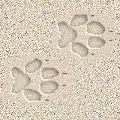 At Albuquerque’s Rio Grande Nature Center, the groups of school kids whom I guided as an interpreter rarely sighted any coyotes, but their tracks were often evident. To help distinguish them from domestic dog tracks, I went through the “3 P’s.” First, the “Paws,” their robust shape and minimal nail imprint. Second, “Perfect-stepping:” When walking, coyotes place their hind feet precisely into the prints of their front feet (as do cats), producing a “two-legged” set of tracks. Finally, the tracks of coyotes are “Purposeful,” meaning that they exhibit intent, or are directed toward a goal or reward. They tend to go in straight lines, from this tree to the cover of that bush, to then intersect with the tracks of a bounding mouse or vole.
At Albuquerque’s Rio Grande Nature Center, the groups of school kids whom I guided as an interpreter rarely sighted any coyotes, but their tracks were often evident. To help distinguish them from domestic dog tracks, I went through the “3 P’s.” First, the “Paws,” their robust shape and minimal nail imprint. Second, “Perfect-stepping:” When walking, coyotes place their hind feet precisely into the prints of their front feet (as do cats), producing a “two-legged” set of tracks. Finally, the tracks of coyotes are “Purposeful,” meaning that they exhibit intent, or are directed toward a goal or reward. They tend to go in straight lines, from this tree to the cover of that bush, to then intersect with the tracks of a bounding mouse or vole. Wild creatures cannot afford to waste energy. In the snow of New Mexico's Sandia mountains, I often noticed the difference between the “purposeful” stride of a coyote or Gray Fox, as opposed to a pet dog’s meanderings. Young coyotes (and young rabbits) appear to “waste’ much energy in play and seemingly mindless scurrying about. However, they are gaining survival skills with a long term payback.
Some behaviors, such as the territorial skirmishes of the Muscovy Ducks on our suburban south Florida lake seem easy to interpret. They are directed at passing on the toughest drake’s genes.
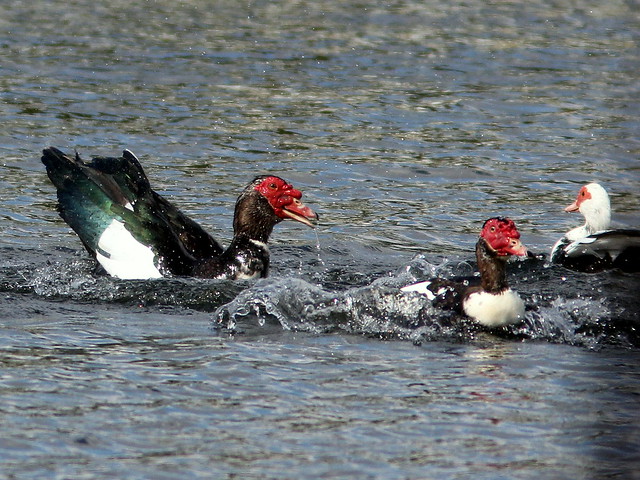
When food is scarce, some birds of prey, such as eagles and owls, may produce two or more chicks, only to have the older and stronger siblings kill their nest-mates. Again, we see the value of this fratricidal behavior, as likelihood of survival of at least one of the progeny is increased.
In January, 2005, one of the Muscovy Ducks that inhabit our lake appeared at our back door with seven newly hatched ducklings, a bit early in the breeding season.
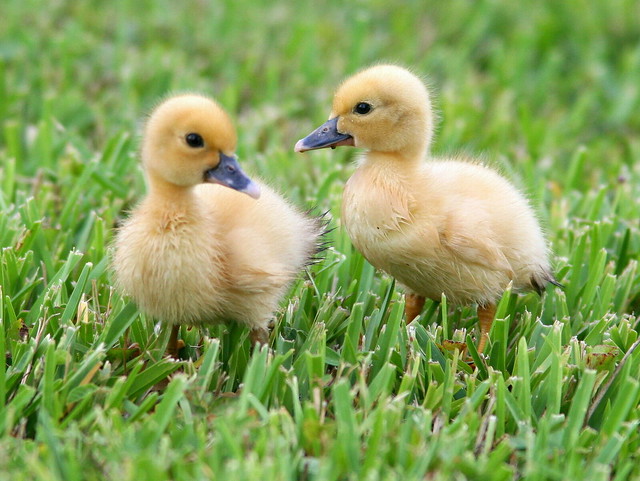
Two days later she was sitting on a neighbor's lawn about 20 feet from the lake's edge with the ducklings under her wings or milling close by. Suddenly as if on signal, twenty or so adult ducks began flying or swimming rapidly towards her, mobbing her.

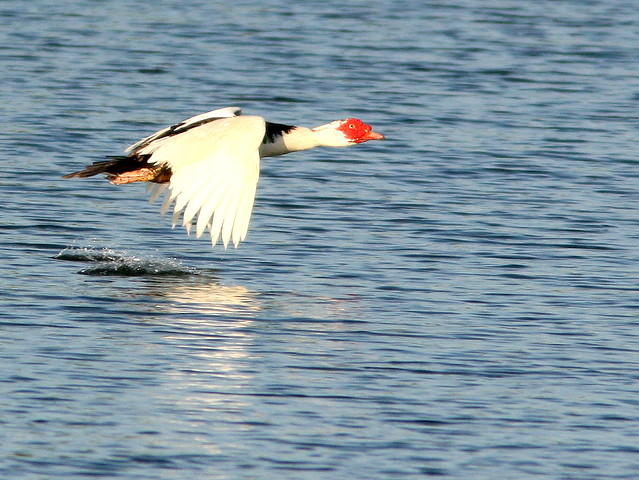
Thinking I saw a yellow ball of fuzz in one of the ducks' mouth, I ran inside to get my binoculars, as the ducks were about 100 yards away. Sure enough, the adults had captured and killed all seven ducklings. They fought over the carcasses and attracted Ring-billed Gulls that stole most of them and flew off.
The ducks were at the height of courtship with lots of head-bobbing, tail-wagging, fights and copulation. Perhaps this had something to do with this (presumably) unusual behavior. The attackers/mobbers appeared to include both sexes.
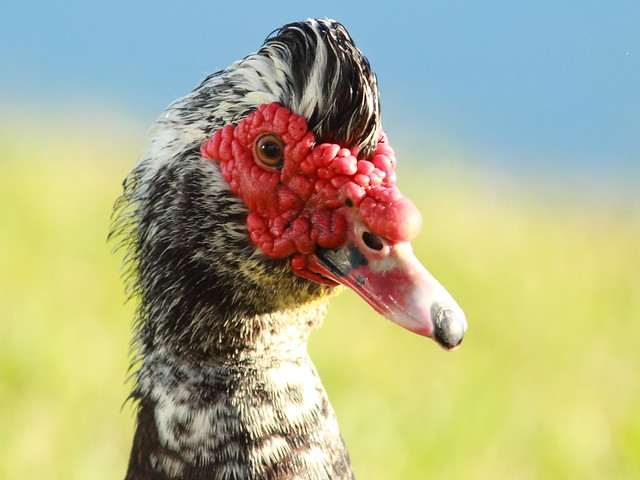
It is difficult to interpret such behavior. Did it carry any survival value? Had the local duck population reached a critical mass that triggered some deep instinct to assure adequate resources, such as food and shelter? Infanticide may be analagous to fratricide-- if the chicks were sired by a rival or non-relative of the the attackers, it might even be more effective, as it also eliminates competing genes.
Early in 2006 I found a hen sitting on 14 eggs under the Cocoplum hedge next to our back patio. Each time she left the nest she covered the eggs completely with down plucked from her breast, then camouflaged the nest with dried leaves. All 14 eggs subsequently hatched (photo), but her brood declined dramatically, day by day. I showed the nest to a young boy from Colombia who was visiting our neighbor. He dropped by to photograph the ducklings when they were 4 days old. That day there were only seven remaining, and the duck family was swimming about 15 feet offshore. Just as he went to take a picture, a large bass broke the surface and instantly disappeared with one of the babies.
Certainly, Red-shouldered and other hawks, Raccoons, turtles and larger herons also take their share of ducklings, but so far I have not witnessed any more ducks killing their own babies. The most serious incident I have observed since the mass infanticide that I reported in January, 2005 has been one case of a drake chasing after a hen with a brood of about 8 chicks that looked to be about one day old.
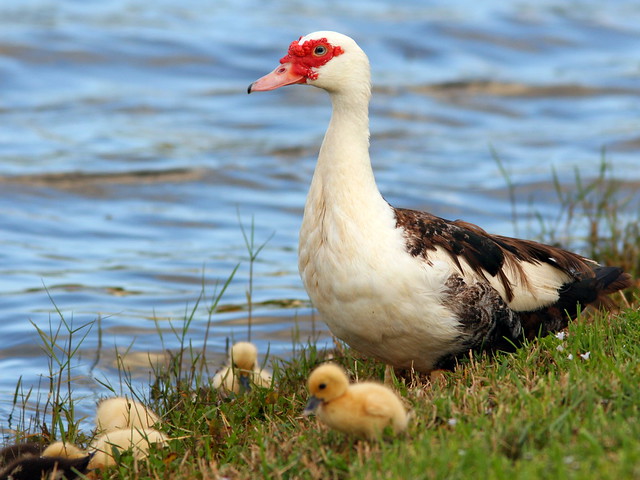
He tried to copulate while she was swimming near shore. She shepherded her chicks out of the lake and they huddled together while she ran away from the drake on the grass, away from the chicks. He chased her into the water and jumped on her, but she dove underwater.
To my surprise she swam away underwater, about 15-20 feet before resurfacing. This evasive diving was repeated several times. He seemed to finally catch her and may have been able to copulate. Then he left her alone and she returned to her chicks after a few minutes.

After I reported the Muscovy infanticide on a birding newsgroup, other birders described similar observations. One lady who lived on a lake in a nearby community wrote that she had been trawling the Internet under the keywords "Muscovy, duck, infanticide" and had found my posting.
“I thought I'd get in touch because I have just witnessed the same behaviour as you describe re a Muscovy duck killing another's chicks… (A)mong the many birds here is a Muscovy duck who started out with 16 chicks a week or so ago, but every day she has one or two less. She is now down to just five. We presumed perhaps a raccoon was using them as snack material, but now we're not so sure because earlier this evening there was quite a flap outside and I looked out to see one of the male Muscovies running off with a chick in his beak. He was being quite rough with it, dropping it on the ground and snapping at it with his beak before keep picking it up and shaking it etc. It was quite horrible to watch as he seemed intent on injuring/killing it.
“The mother duck, meanwhile, had taken refuge on top of our pool screen and was clucking loudly, which was what had caught my attention. Her other four chicks were lying in the grass without her protection. This is not the first time that we have seen this male bullying a mother with chicks, but it is the first time we have seen him try to kill one and we wondered if maybe he's responsible for the loss of the others too. I took a few paces towards him and he dropped the chick, who I then shooshed into the water and guided him back to his mum, who by now had flown back down to protect her other chicks. The little one looked quite shaken up, but is OK… It's quite bizarre and
while I understand the need for natural selection and population control etc. this just seemed quite brutal for a duck to kill one of its own.”
Another Florida resident wrote: “Muscovies are not the only species to kill ducklings! I witnessed male mallards killing Muscovy ducklings by drowning in one of the small retention lakes at South Regional Library in Pembroke Pines many years ago (1990?) It was most unpleasant because I had taken my nieces (then aged about six and eight) to see the pretty ducks at the lake...it was a sad lesson in nature's toughness.”
A reader from South Africa added her observations, suggesting that parental inexperience may be a factor in this case: “I have a problem with my Mallard father. He is killing his own ducklings. I went onto the web and found your writings about the problem. The hen laid 18 eggs. 16 hatched. In the first week the male started attacking the ducklings. He took them in his beak and shaking them vigorously, he killed four of them. Just as I wanted to intervene, he stopped.
“Now, three weeks later, he started again. I caught him and put him into a cage, but the mother did not stop quaking and he flew up against the wire. I released him again but this morning he killed another baby. I was wondering if finding another female might do the trick. The ducks roam freely. They love to swim in the pool. As far as I know, there was no disturbance or any stress for the ducks. The father duck was very protective at the beginning. Then all of a sudden he attacked the ducklings.
“At first I thought he was only teaching them some manners (ha-haaa) but soon realized it isn’t case. This morning I separated the ducklings from the pair for two hours. As soon as I let them loose, he immediately attacked one. So, the "awful stepmother" took him to the house next door and put him in a bigger cage further away from the mother and ducklings. I have phoned a friend of mine to find me another female, so I will definitely keep you posted.
“My friend told me that they encountered a similar problem two years ago. For no apparent reason, the male first destroyed some eggs, and then attacked the ducklings, killing them. This year though, he is an excellent father. She said they came to the conclusion the mister was just young. I sincerely hope this is the case.”
In Texas Nature Blogspot, a nature writer describes infanticide in Purple Martins and summarizes theories as to the cause and value of this behavior.
A FEW GLEANINGS FROM THE LITERATURE:
Eugenie C. Scott wrote in a review of “Infanticide: Comparative and Evolutionary Perspectives,” that avian infanticide is not a "rare, pathological aberration brought about by unusual conditions. It is too common. The behavior has more recently been considered as an adaptive response at the population level to pressures such as overpopulation, or as an adaptive response by individuals.”
High breeding density appears to have increased the aggression of a female to the point of infanticide in the Spot-billed Duck (Anas poecilorhyncha) observed on a small pond at Yatsu tidal flat, central Japan, from May to June 2000.
"...(S)ix families of conspecific and one Gadwall A. strepera family, respectively, occupied territories. A female Spot-billed Duck with 11 ducklings attacked ducklings of all the other families killing eight conspecifics and three of the Gadwall. High breeding density (15.0 families/ha) may have increased the aggression of the female." [A case of infanticide in the Spot-billed Duck in circumstances of high breeding density : Tetsuo Shimada, Kazuyuki Kuwabara, Saori Yamakoshi, Tomomi Shichi, Abstract]
Competition for nest sites, mates or food is implicated in this study of European Starlings:
"Avian adult infanticide (the killing of conspecific young by an adult) has been reported for several species (e.g.: Crook and Shields 1985, Loftin and Roberson 1983. Trail et al. 1981). Here we document one case of attempted infanticide and circumstantial evidence for 3 more cases of infanticide in the European Starling (Sturnus vulgaris).
"In all cases, the nature of the wound was the same: a peck mark near one of the auditory openings. Similar wounds have been reported by Crook and Shields (19 8 5) Shelley (1934), and Stacey and Edwards (1983) in the context of infanticide…. In addition, similar peck marks have been found around the head and neck of dead adults (n = 3) found in nest boxes, and on the faces of pairs of birds that we have captured fighting inside boxes (n = 8 pairs), suggesting that bill stabbing is not uncommon.
"In two of the four cases, a female was suspected to have committed an infanticidal act. We suspect that infanticide in our population is related to competition for nest sites, a limiting resource (e.g., see Hrdy 1979). Other reports of female infanticidal behavior have been reported by Loftin and Roberson (1983) and Picman (1977). In both cases, a limiting resource (such as nests, mates or food) has been suggested as a reason for infanticidal acts.
"The importance and frequency of avian infanticide is largely unknown primarily because the observation time necessary to document this phenomenon can be prohibitive. As a result, infanticide may have greater biological significance than is implied by the existing literature. We encourage all observers to be cognizant of the possibility of infanticide in their study populations."
Intruding males and females may gain a reproductive advantage by killing the young of prospective mates [Prospective Infanticide and Protection of Genetic Paternity in Tropical House Wrens]:
"Sexually selected infanticide occurs when adults kill dependent offspring of potential mates and initiate new reproductive attempts with those mates more rapidly than if they had waited for the offspring to become independent."
This post is based upon a series of blogs I first published in 2006. The full-format photos are more recent than the events described, as I was not a photographer when I authored the original articles. Ken
No comments:
Post a Comment
Thank you for visiting Rosyfinch Ramblings! I will enjoy a visit to your page just as soon as possible. Some anonymous comments and some containing active links may not be accepted.